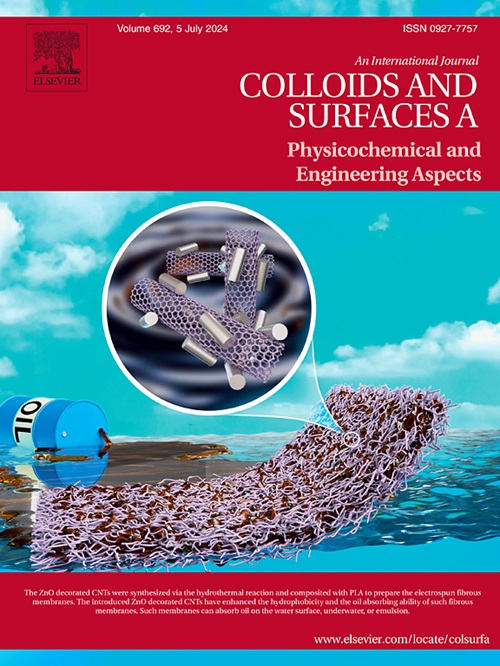Dynamic characteristics of droplet impact on a cold cylindrical surface
IF 4.9
2区 化学
Q2 CHEMISTRY, PHYSICAL
Colloids and Surfaces A: Physicochemical and Engineering Aspects
Pub Date : 2024-10-09
DOI:10.1016/j.colsurfa.2024.135523
引用次数: 0
Abstract
The freezing phenomenon often leads to economic and safety losses in various industries. Studying the processes of droplets impact on cold surfaces is beneficial in preventing potential harm. In this study, the processes of droplet impact on a cold cylindrical surface are investigated by high-speed photography. How the dynamic characteristics are affected by Weber number and surface temperature are studied. The results indicate that when the surface temperature is between −25 to −5 °C, an increase in Weber number results in higher initial kinetic energy and greater viscous dissipation. During the spreading process, the initial kinetic energy predominates, leading to an increase in the maximum spreading ratio. However, the rise in viscous dissipation contributes to an increase in the stable ratio. As Weber number increases, both the maximum spreading time and stable time decrease. Over the same range of surface temperatures, a decrease in surface temperature results in increased viscous dissipation, which leads to a reduction in the maximum spreading ratio. The maximum spreading time and stable time, however, are not significantly affected by surface temperature. Moreover, the relationships of the maximum spreading ratios and stable ratios between axial and circumferential directions are constructed respectively. These relationships exhibit similar linear characteristics, which are not affected by the Weber number and surface temperature.
液滴撞击冷圆柱表面的动态特性
在各行各业中,冰冻现象往往会导致经济和安全损失。研究液滴冲击冷表面的过程有利于预防潜在的危害。本研究利用高速摄影技术研究了液滴冲击冷圆柱表面的过程。研究了韦伯数和表面温度对动态特性的影响。结果表明,当表面温度在 -25 至 -5 °C 之间时,韦伯数增加会导致初始动能增大和粘性耗散增大。在铺展过程中,初始动能占主导地位,导致最大铺展率增加。然而,粘性耗散的增加会导致稳定比的增加。随着韦伯数字的增加,最大扩展时间和稳定时间都会缩短。在相同的表面温度范围内,表面温度降低会导致粘性耗散增加,从而导致最大铺展率降低。但最大铺展时间和稳定时间受表面温度的影响不大。此外,还分别构建了轴向和圆周方向的最大铺展比和稳定比关系。这些关系表现出相似的线性特征,不受韦伯数和表面温度的影响。
本文章由计算机程序翻译,如有差异,请以英文原文为准。
求助全文
约1分钟内获得全文
求助全文
来源期刊
CiteScore
8.70
自引率
9.60%
发文量
2421
审稿时长
56 days
期刊介绍:
Colloids and Surfaces A: Physicochemical and Engineering Aspects is an international journal devoted to the science underlying applications of colloids and interfacial phenomena.
The journal aims at publishing high quality research papers featuring new materials or new insights into the role of colloid and interface science in (for example) food, energy, minerals processing, pharmaceuticals or the environment.

 求助内容:
求助内容: 应助结果提醒方式:
应助结果提醒方式:


